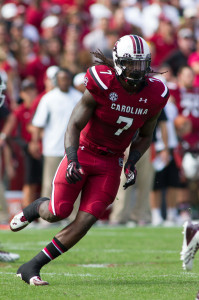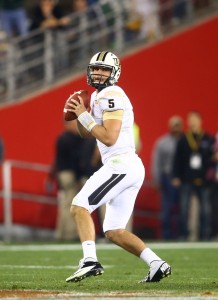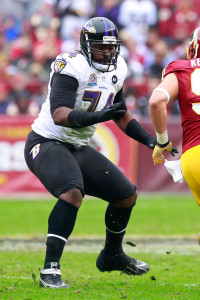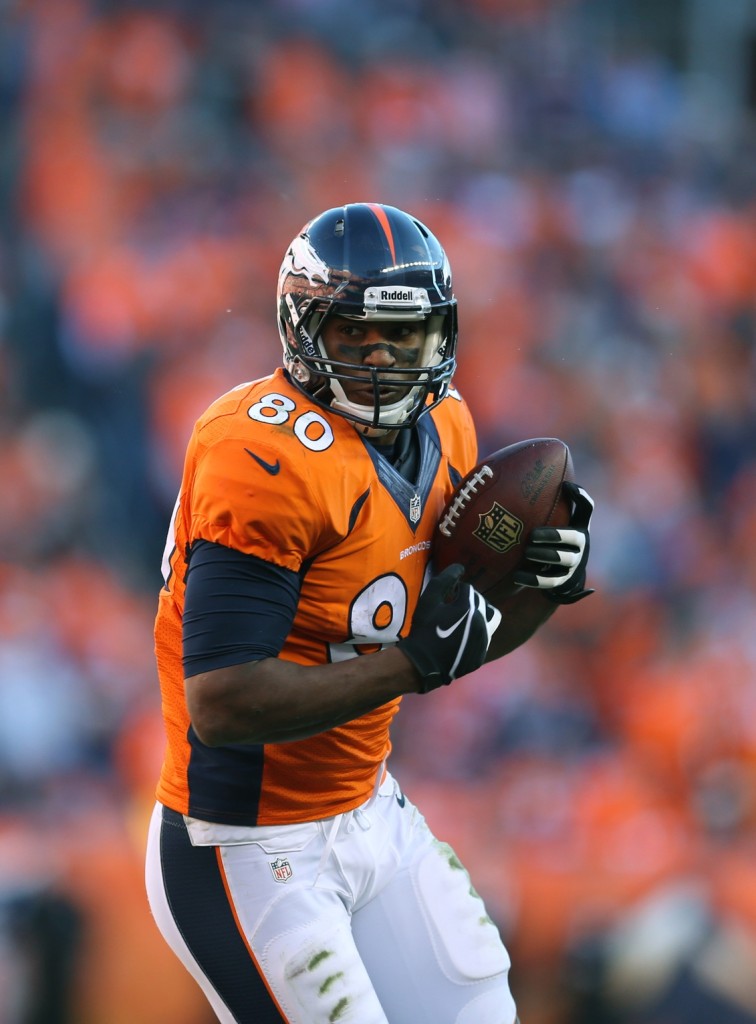Notable signings:
- Corey Graham (CB): Four years, $16.3MM. $5.5MM guaranteed.
- Chris Williams (G): Four years, $13.15MM. $3.5MM guaranteed.
- Dan Carpenter (K): Four years, $9.95MM. $2.15MM guaranteed.
- Scott Chandler (TE): Two years, $4.75MM. $1.2MM guaranteed.
- Keith Rivers (LB): Two years, $4.05MM. $1MM guaranteed.
- Brandon Spikes (LB): One year, $3.25MM. $900K guaranteed.
- Anthony Dixon (RB): Three years, $3.5MM. $750K guaranteed.
- Brian Moorman (P): One year, minimum salary benefit.
- Jarius Wynn (DE): One year, minimum salary benefit.
Notable losses:
- Jairus Byrd (S)
- Alex Carrington (DE)
- Kevin Kolb (QB): Released
- Jim Leonhard (S)
- Arthur Moats (LB)
- Thomas Welch (OT)
Extensions and restructures:
- Aaron Williams (S): Extended through 2018. Four years, $26.008MM. $8.5MM guaranteed.
Trades:
- Acquired Mike Williams from the Buccaneers in exchange for a sixth-round pick (No. 185).
- Acquired a first-round pick (No. 4) from the Browns in exchange for a first-round pick (No. 9), a 2015 first-round pick, and a 2015 fourth-round pick.
- Acquired a conditional 2015 fourth-round pick from the 49ers in exchange for Stevie Johnson. Pick could become a third-rounder depending on Johnson’s performance.
- Acquired a second-round pick (No. 44) and a fifth-round pick (No. 153) from the Rams in exchange for a second-round pick (No. 41).
- Acquired Bryce Brown and a seventh-round pick (No. 237) from the Eagles in exchange for a seventh-round pick (No. 224) and an additional draft pick that will be either a 2015 fourth-rounder, a 2016 third-rounder, or a 2016 fourth-rounder, depending on conditions met by Brown’s and Stevie Johnson‘s performance.
- Acquired a seventh-round pick (No. 221) and a 2015 fifth-round pick from the Buccaneers in exchange for a fifth-round pick (No. 149).
Draft picks:
- Sammy Watkins, WR, Clemson (1.4): Signed
- Cyrus Kouandjio, OT, Alabama (2.44): Signed
- Preston Brown, LB, Louisville (3.73): Signed
- Ross Cockrell, CB, Duke (4.109): Signed
- Cyril Richardson, G, Baylor (5.153): Signed
- Randell Johnson, OLB, Florida Atlantic (7.221): Signed
- Seantrel Henderson, OT, Miami (FL) (7.237): Signed
Other:
- Had longtime owner Ralph Wilson pass away, prompting the franchise sale process to get underway.
- Hired Jim Schwartz as defensive coordinator.
- Learned that Kiko Alonso will be sidelined for the 2014 season with an ACL injury.
- Exercised Marcell Dareus‘ fifth-year option for 2015 ($10.633MM).
- Signed 10 rookie free agents after the draft.
Heading into the 2014 offseason, Bills fans were still perhaps left wondering what might have been. A once-promising 2013 campaign had sputtered after E.J. Manuel, the first quarterback taken in the 2013 NFL draft, suffered multiple knee injuries. Despite a pleasantly adequate cameo from ex-Duke Blue Devil Thad Lewis under center in Manuel’s absence, the Bills’ passing offense was among the league’s worst. On the ground, however, the Bills had the second-most prolific rushing attack in the NFL on the legs of C.J. Spiller, who provided the lightning to Fred Jackson‘s thunder in the Buffalo backfield.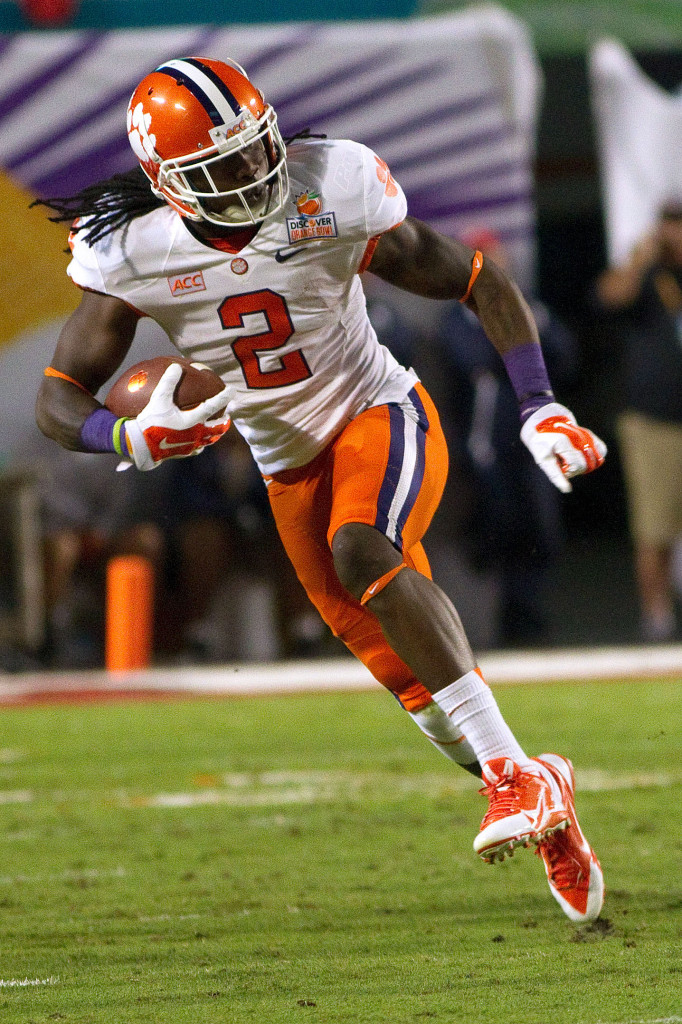
The defense also experienced a considerable resurgence, as a unit led by the $100 million man Mario Williams and PFWA Defensive Rookie of the Year Kiko Alonso recorded a franchise-record 57 sacks. Despite an uninspiring 6-10 finish, the Bills showed some signs of promise, so the question heading into 2014 was whether Buffalo would push to contend in the short term, or whether the front office would believe the club was still multiple successful offseasons away from becoming a serious playoff contender.
On the offensive side of the ball, the Bills’ biggest move undoubtedly occurred in the 2014 draft when they decided to trade their 2014 and 2015 first-round picks to the Browns in order to move up and draft three-time All-American receiver Sammy Watkins out of Clemson with the fourth overall pick. In order to make room in the offense for Watkins, former No. 1 wideout Steve Johnson, who registered at least 75 receptions and 1,000 yards every season from 2010-2012, was dealt within 24 hours of Watkins’ selection to the 49ers for a conditional 2015 fourth-round pick.
Highlighting the Bills’ additional skill position acquisitions were receiver Mike Williams, who arrived via trade from the Buccaneers and played for Bills’ head coach Doug Marrone during their overlapping tenures at Syracuse; and Anthony Dixon, the bruising Pittsburgh product who played in a limited hybrid halfback/fullback role for the 49ers over the past few seasons. In addition to bringing in Dixon, the Bills also traded for former Eagle Bryce Brown, who enjoyed a brief stint in the national spotlight in late 2012 while filling in for an injured LeSean McCoy, to provide further depth at running back.
Arguably the Bills’ most substantial offensive positional turnover this offseason occurred along the offensive line. The team signed Chris Williams, who will look to start at guard after establishing himself as an NFL regular with the Rams over the past four seasons. The Bills drafted former Alabama tackle Cyrus Kouandjio, whose questionable knee health caused him to fail several physicals leading up to the the draft, and added two more lineman in the draft: guard Cyril Richardson out of Baylor and Seantrel Henderson of Miami in the seventh round. Henderson is perhaps the most mercurial boom-or-bust prospect of the 2014 draft class, having failed numerous drug tests, including one at the NFL combine, after coming out of high school in 2010 as the top overall recruit in the country. While the Bills’ new-look line will have a lot to prove on the field, they will enter the 2014 season as the heaviest unit in the entire NFL by a wide margin.
Defensively, any discussion of the Bills’ offseason has to start with the departure of three-time All-Pro safety Jairus Byrd, who signed a six-year deal with the Saints. Byrd left a defense that found itself in a substantial transition period, as the unit’s leadership had been handed over from Mike Pettine, who took the Browns’ head coaching position, to former Lions’ head coach Jim Schwartz.
Much has been written about the fairly substantial tactical change from Pettine’s ‘4-3 under’ base defense to Schwartz’s patented ‘Wide 9’ formation. The transition will not be made any easier by the recent shocking season-ending injury to Alonso, who had become a playmaker and fan favorite in his accoladed rookie season. Luckily for the Bills, GM Doug Whaley decided to add substantial linebacker depth this offseason, signing both Brandon Spikes and former first-round pick Keith Rivers while also selecting Louisville standout Preston Brown in the third round of the draft. Whaley has, however, received significant criticism for making no attempt to fill the void at safety left by Byrd.
Heading into 2014, the one question on Bills’ fans minds, other than whether or not their franchise will be based in Toronto in 10 years, will be whether or not Watkins was worth two first-round picks. He is widely expected to become an NFL star, but one has to wonder whether or not it is viable for a rebuilding franchise to surrender a future first-round pick in any trade, no matter the return. The Buffalo faithful will be hoping that Watkins can help Manuel, who showed flashes of brilliance when healthy last season, continue to develop into one of the NFL’s premier young talents at quarterback. Even if everything breaks right for the Bills, a tough schedule, highlighted by an in-conference divisional pairing with the suddenly daunting AFC West, will likely prevent the team from finishing at .500 or better in 2014.
Spotrac and Over The Cap were used in the creation of this post.
Photo courtesy of USA Today Sports Images.
